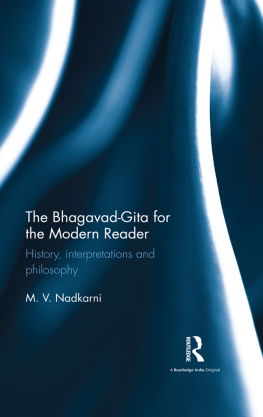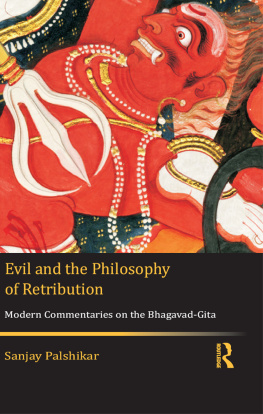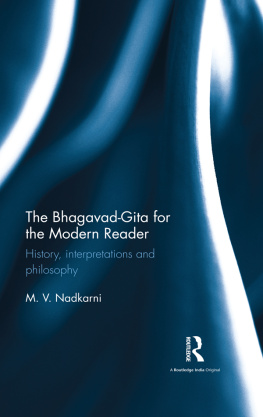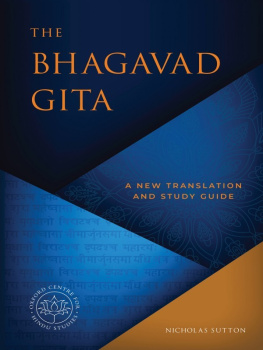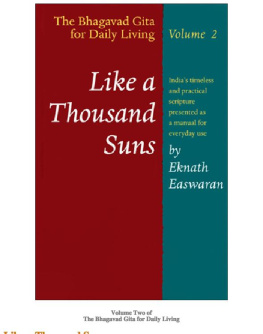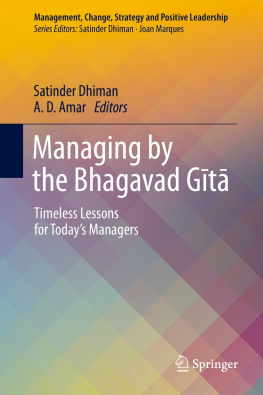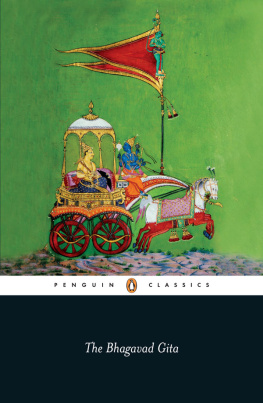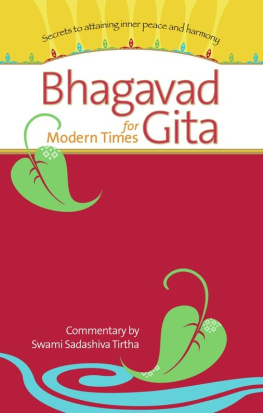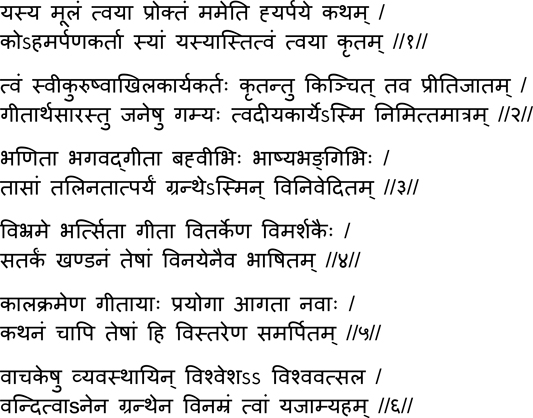2017 M. V. Nadkarni
The right of M. V. Nadkarni to be identified as author of this work has been asserted by him in accordance with sections 77 and 78 of the Copyright, Designs and Patents Act 1988.
All rights reserved. No part of this book may be reprinted or reproduced or utilised in any form or by any electronic, mechanical, or other means, now known or hereafter invented, including photocopying and recording, or in any information storage or retrieval system, without permission in writing from the publishers.
A catalog record has been requested for this book.
Transliteration
Yasya m u lam tvay a proktam mameti hyarpaye katham /
Koaham arpa n a-kart a sy a m yasy a stitvam tvay a kritam //1//
Tvam sweekuru sh w a khil a karyakartah kritam tu kimchit tava pr i tij a tam /
G i t a rthas a rastu jane sh u gamyah tvad i ya k a ryesmi nimittam a tram //2//
Bha n it a Bhagavadg i t a bahv i bhih bh a shya-bhangibhih /
T a s a m t a lina-tatparyam granthesmin viniveditam //3//
Vibhrame bhartsit a G i t a vitarke n a vimarshakaih /
Satarkam khan d anam tesh a m vinayenaiva bh as hitam //4//
Kalakrame n a G i t a y a prayog a a gat a nav a h /
Tesh a m kathanam ch a api savistare n a samarpitam //5//
V a chakeshu vyavasth a yin Vishwesha-a Vishwa-vatsala /
Vanditv a anena granthena vinamram tv a m yaj a myaham //6//
Translation
How can I dedicate this as mine whose source is (as) told by You?
Who am I to dedicate whose existence is created by You? //1//
Even then, Oh Doer of Everything, accept
what little is done born from your love!
The essence of the Gita needs to be disseminated among people;
I am just an instrument ( nimitta ) in Your own work. //2//
The Bhagavad-Gita is spoken of by numerous waves of ( bhangibhih ) commentaries;
their underlying ( talina ) purport ( tatparyam ) is narrated in this book. //3//
The Gita has been criticised in confusion by critics with false arguments;
their refutation is presented (here) logically and politely only. //4//
In the course of time, new applications ( prayogah ) of the Gita have come into vogue;
their narration is also offered in good detail. //5//
Through this book, I salute (and) propitiate ( yaj a mi ) You in all modesty, the Lord of the universe,
(who is) affectionate to all, and nicely abiding among the readers. //6//
[The original Sanskrit verses and their translation are both by the author]
Note: Page numbers in italics indicate tables.
adharma
Advaita
Advaita, Dvaita and Vishi shta dvaiata: Reconciliation
ahamk a ra
akart a
akshohi n is n3
ananda
An u -G i t a
atheist
Atman
avat a ra
bhakti
BORI
Brahmas u tras
brahma-vidya
brand value
Buddhism
caste, caste system
charity
code of conduct
corporate social responsibility
death, perspective on
deontology
desire, the Gitas attitude to
detachment
dharma
Dvaita
Dvait a dvaita
ethics in the Gita
free will in the Gita n11
Gita, the: authorship of
happiness and the Gita
Hinduism
holistic approach/view
humility
jn a na-m a rga (yoga)
Jnaneshwari
karma-m a rga (yoga)
Karnataka Bhagavadgite
kart a
loka-hita/loka-sangraha
Mahabharata , the
Mani sha -panchakam
Marxism
ma t has
m a y a
meditation n8
mind, states of
modern leaders of Indian Renaissance-their three thrusts
moha
moksha/mukti (liberation)
non-attachment
non-violence
pancha-bhedas
personnel management
prapatti
Prasth a nat r iya
Pur an as
purush a rthas
Renaissance, Indian
Rigveda
rituals
sacred text
S a dhan a
Sankhya
sarva-bh u ta-hita
Satya: A dhy a tmika and Vy a vah a rika
self
shadvairis
shar i ra - y a tr a
shraddh a n2
shramad a na
Shuddh a dvaita
sin/sinner, Gitas attitude to
success in life
svakarma
sw(v)adharma
theosophical society
three stages in the spread of the gita
trigunas ( s a ttvika, r a jasika and t a masika )
truth pursuit in research
upanishads
Uttara-G i t a , the
var n as
virtuous cycle ( chakra )
Vishi shta dvaita
Vishwarupa
work ethics
world-its reality
yajna
yoga-shastra
Contents
- Maharishi Mahesh Yogi;
A didev a nanda, Sv a mi (Tr.) (2014; first published in 1992). Shr i R a m a nuja G i t a Bh a shya (with Text and English Translation) . (With an Introduction by Sv a mi Tapasy a nanda). Madras (Chennai): Sri Ramakrishna Math.
Agarwal, Satya P. (1993). The Social Role of the Gita How and Why . Delhi: Motilal Banarasidass.
Agrawal, Purushottam (2004). Nija Brahma Vich a r Dharma, Sam a j, aur Dharmetar Adhy a tm (Hindi). New Delhi: Rajakamal Prakashan.
Agrawal, Purushottam (2006). Decoding the Ethics of Srimadbhagavadgita , The Book Review , 30(1 and 2), JanuaryFebruary, p. 29.
Ambedkar, B. R. (2004). Krishna and His Gita, in Valerian Rodrigues (Ed.), The Essential Writings of B. R. Ambedkar . New Delhi: Oxford University Press, pp. 193204.
Amur, G. S. (2013). Lokay a tre (Kannada). Bengaluru: Priyadarshini Prak a shana.
Anandashram, Swami (2014). Advaita Ved a nta a ni Bhaktiyogu (from a lecture in Konkani), The Chitrapur Sunbeam , 21, July 7, pp. 58.
Anon (2011). Nagarasa Kaviya Karnataka Bhagavadgite (Kannada). Bengaluru: Bharatiya Vidya Bhavan.
Arendt, Hannah (1970). On Violence . San Diego: Harcourt Brace.
Aurobindo, Sri (1996; ninth edition). Essays on the Gita . Pondicherry: Sri Aurobindo Ashram.
Aurobindo, Sri (1999). The Synthesis of Yoga . Pondicherry: Sri Aurobindo Ashram.
Aurobindo, Sri (2010; first published in 1993). Integral Yoga: Sri Aurobindos Teachings and Method of Practice (Selected Letters of ). Pondicherry: Sri Aurobindo Ashram.
Badrinath, Chaturvedi (2007; first published in 2006). The Mahabharata: An Inquiry in the Human Condition . Hyderabad: Orient Longman.
Balagangadhara, S. N. (1994). The Heathen in His Blindness Asia, the West and the Dynamic of Religion . Leiden: E. J. Brill (published in India by Manohar, New Delhi, in 2005).
Banavathy, Vinayachandra K. and Anuradha Choudry (2014). Understanding Happiness: A Vedantic Perspective, Psychological Studies , 59(2), June, pp. 14152.

